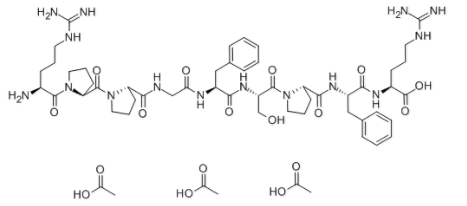2018-02-05
Overview of the kinin system
Kinins are peptide hormones that are formed as part of the kinin-kallikrein system (KKS). kinin peptides are potent vasodilators and also promote diuresis and natriuresis. Kinins protect against ischemia-reperfusion injury by decreasing endothelial adherence of leucocytes, leading to attenuation of post-ischemic leukocyte adherence, attenuation of disruption of the microvascular barrier and reduced tissue injury. They regulate coronary vascular tone and mediate the hypotensive effects of inhibition of angiotensin-converting enzyme. They also participate in inflammation, pain, growth modulating and cardioprotevtive effects of preconditioning. Most research efforts of the kinins that research has focused on are bradykinin (BK), kallidin (KD), des-Arg10KD and des-des-Arg10BK.

| CAT# | 10-101-72 |
| Product Name | Bradykinin Acetate |
| CAS No. | 6846-03-3 |
| Sequence | H-Arg-Pro-Pro-Gly-Phe-Ser-Pro-Phe-Arg-OH acetate salt |
| M.W/Mr. | 1060.22 |
| Molecular Formula | C50H73N15O11 |
Overview of the bradykinin
Bradykinin is a member of a family of peptides known as the kinins, the other significant member being kallidin (KD or Lys-BK), which is BK with a lysine residue at the N-terminus. The kinins are formed from precursor α2-globulin proteins known as kininogens, predominantly through the activity of enzymes called kininogenases or kallikreins. There are two types of kininogens, high-molecular weight kininogen (HMWK) and low molecular weight kininogen (LMWK); cleavage of HMWK by kallikreins produces BK and cleavage of LMWK produces Lys-BK. Although the kinins are active in normal physiology, the major role of these peptides seems to be as a local response to tissue injury and as an agent to aid in tissue repair. Kallikreins found in various tissues are activated to produce the kinins by a number of physiological traumas.
Bradykinin (BK) is a nine residue endogenous peptide first characterized in 1949 for its ability to contract smooth muscle. Since that time further elucidation of the physiological role of BK, and also its implication in a variety of pathological disorders, has made inhibition of BK activity a significant goal in medicinal chemistry. A brief survey of the physiological activity of BK will help clarify why this peptide is an attractive therapeutic target.
The effect of bradykinin
Bradykinin has a chemotactic and stimulatory effect on immune ceils, can degranulate mast cells, and is able to activate sensory fibers in nociceptive pathways to produce pain, a response which sensitizes an injury (hyperalgesia) and prevents further damage. Overall, the ability of BK to induce all the cardinal symptoms of inflammation (vasodilation, edema, and pain), in addition to its interaction with leukocytes and ability to induce other pro-inflammatory substances (leukotrienes, prostaglandins, platelet-activating-factor, substance P), has implicated this peptide as a major agent in the pathology of inflammation.
It has been suggested that bradykinin (BK) plays an important role in regulating neointimal formation after vascular injury. However, implication of BK in the growth of rat vascular smooth muscle cells (VSMC) is controversial. Therefore, by examining the mitogenic effect of BK on VSMCs associated with activation of MAPK we reach to specific conclusions. The mitogenic effect of BK is mediated through activation of the Ras/Raf/MEK/MAPK pathway similar to that of PDGF-BB. BK-mediated MAPK activation was modulated by Ca2+, PKC, and tyrosine kinase all of which are associated with cell proliferation in rat cultured VSMCs.
References:
Yu, J. (2004).?Structure/function Studies of Bradykinin B2/angiotensin II AT1 Receptor Hybrids?(Doctoral dissertation, Boston University).
Kennedy, K. J. (1999).?Potent Derivatives of the Bradykinin B2 Receptor Antagonist Hoe 140 Containing Analogues of Arginine and Lysine with Increased Hydrophobicity?(Doctoral dissertation, Medical University of South Carolina).